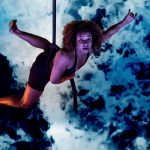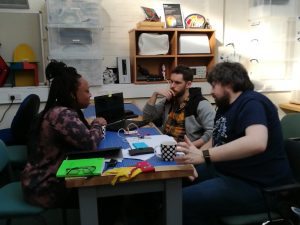
XR Circus is a project led by researchers but driven by performance practitioners who want to explore the potential of combining circus with new technologies. Now that our creatives have has a chance to reflect on what it was like presenting their XR Circus work to audiences, we’ve asked them to share some of their thoughts. This is an edited account of what they had to say…
On the XR Circus team:

Thomas Jancis, Trajectory Theatre: Working with XR Circus I have found the variety of passions from the various practitioners to be greatly inspiring. … I think having a team has been incredibly useful as a support structure and soundboard for ideas.
Emma Cat: It was inspiring getting to meet and work with people like Kelly and Robert, to learn about the incredible projects they are working on… [and] the other artists on the project
Carolyn Watt: Its been really fantastic being able to bounce ideas of fellow XR-ers, test things out on the spot (such as the head set experience in Great Yarmouth with different choreo) and also see how others approach the different types of technology.
On the process:
Victoria Amedume: Working hands on with software and equipment made available to us, supported by expertise of digital practitioners, has been brilliant but challenging. The focus on the circus artists creating content ourselves initially felt difficult, I went back to feeling unskilled and clumsy as a maker. However, without rolling up my sleeves and trying stuff myself I don’t think I would have reached the point we are now. I have surprised myself by how much I have been able to use software to produce short programmes, edit 360 sound and video.

Emily Martin, Trajectory Theatre: Having not spent much time working with technology, the project has introduced me to new ways of thinking, and broadened the possibilities for future work. There have been some challenges along the way, like how to mo-cap a person to make them look like a horse… but with all the challenges have come new ways to solve them …because of the expertise in the room.
Emma Cat: the only new technology used in the performance were the interactive projections that Mark was making for me, but the first time we tried that was during my performance… I was obviously completely occupied with performing my routing, so won’t be able to tell what it looked like until I get to see video from the show.
Carolyn Watt: originally I had planned to live stream the 360 as a projection which would then just be viewed by the audience in situ, however as the technology wasn’t available for this, we went down the live streaming route, which actually engaged with more people and offers an entirely different experience. …this was certainly an unexpected positive.
Rowan Fae, Full Tilt Aerial Dance: Our experiences in the fablab really opened up a world of hands on, super geeky making to me. I fondly remember holding a circuit board in my hand in one of the early workshops and thinking I get it
On the artistic challenge:

Emily Martin, Trajectory Theatre: I think the biggest challenge …was to not loose the focus of the story telling and human connection in the experiences; we needed to keep a tighter hold on the narrative and story behind the technology to ensure that the final product was not just a show of computers, but …interactive and engaging as well.
Emily Cat: I ended up having to work in a way that I wasn’t used to. I like to plan ahead and give myself time to develop ideas, but …it wasn’t possible to explore and experiment as I would have hoped. …I think that the combination of the venue not being suited to the screens/projections I required coupled with … the developmental process led to me feeling like …I lost some of the creative clarity of my work
Rowan Fae: I dreamt of a beautiful avatar that shifted from formed to losing form and into formless, telling a tale of the loss of self within a world of the hyperreal where the virtual and real become entwined. …There seemed to be barriers to achieving my artistic vision using the more complex technology, someone had to program and generate the beautiful avatars I imagined. …an awful lot of time spent getting computers to talk to each other. I did learn a lot from the process and could see that with more time and tweaks the more challenging ideas could too come to fruition.
On skill:
Emma Cat: Learning to use and working with Ableton was interesting but difficult and led to a few bleary eyed sleepless nights. …I surprised myself by creating the soundscape for my routine …the process has confirmed to me how important the audio element is in creating an immersive world
Victoria Amedume: Even with the frustration realising, that like circus, to achieve what I want to required a far higher level of skill with digital media than I could reach in the time; this stage of XR Circus has enabled us to generate a strong vision for the connection of digital to our circus practice.
On the practicalities of the event:

Carolyn Watt: on the day, we realised… our only option was Facebook [livestreaming] …And actually Facebook was a really effective platform, as it allowed external audience members to comment live, use emoticons etc. So although it didn’t quite go to plan, it was useful to work out that Facebook is perhaps a better platform for this work over YouTube.
On audience response:
Rowan Fae: Interestingly the showing and the subsequent commentary on social media highlighted that the ‘simple’ ideas that I found to be most effective were also enjoyed most by the live audience.
Thomas Jancis, Trajectory Theatre: The feedback for ‘Circus in a Bottle’ has been wonderful with audience members calling it “beautiful” [and] “simple but great”
On future development:
Roderick Morgan, Trajectory Theatre: The showing for us threw up the usual things; stuff that should have worked but didn’t, stuff that shouldn’t have worked but did, stuff that wasn’t even in the performance but somehow became a central part of it. …Though we had spent a great deal of time finding interesting circus history stories to present, what we needed, and what we will be doing in the next iterations of this project, is finding a way to place these anecdotes in a wider story that involves our audience.
On future practice:

Roderick Morgan, Trajectory Theatre: This project has really made me consider the point at which fiction and non-fiction meet. We wanted to represent the often harsh and unfortunate lives of a group within society who make their livings based on their feats and triumphs. We had to look at providing the audience with both of these facets simultaneous[ly] whilst still making work that played in to the wonderful and amazing. I don’t think we hit this right but we have a better idea of how to do this in the future.
Victoria Amedume: It… opened up thinking about how we can become better storytellers, finding way to layer stories between different media and discovering how different media can communicate, interact and support each other to create-multi-textured experience. …we now have the language and understanding of the potential to dig deeper into those ideas and realise them more fully.
*Carolyn Watt’s PhD is part funded by the Interreg 5A France (Channel) England Research project PONToon, June 2017-November 2020, led by the University of Portsmouth, CCI
If you want up to hear about how the XR Circus continues to develop follow @XRCircus and keep an eye on #XRCircus.















